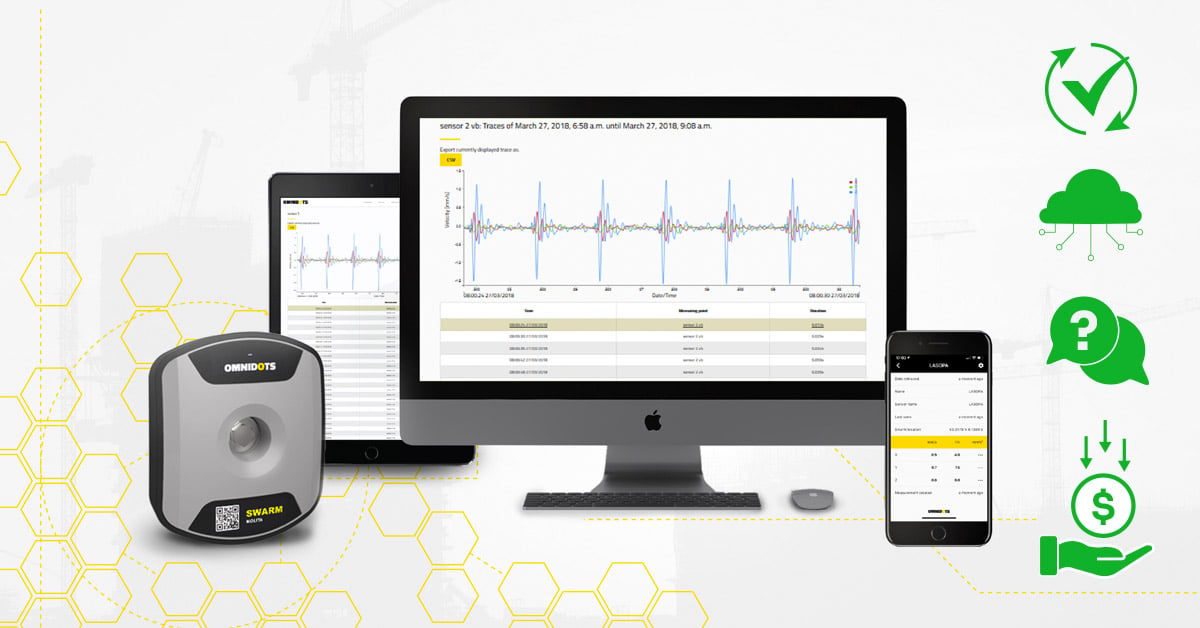Vibration monitoring is essential to determine whether the vibration levels released by construction activities or an infrastructure project remain within acceptable values. These values relate to the risk of building damage or the potential nuisance for people living or working in buildings.
You must be quickly informed of any exceedances of the vibration standard. This can be pretty challenging, especially since modern equipment makes it easy to measure remotely. You may not be physically present at the construction site. Fortunately, the brains responsible for the technology have found a solution: automatic alarm notifications whenever the vibration standard has been exceeded. In this blog article, you can read how this works and what the possibilities are.
Vibration standards: how to determine them?
Several factors combine to determine the vibration standard for a given project. We briefly list them here for you.
The condition and function of a building
The condition and function of a building are important factors in establishing a maximum and/or acceptable vibration standard. It is obvious that an old monumental edifice that has already been scarred by the ravages of time can handle a lesser vibration load than a recently built state-of-the-art concrete building. Determining the condition and state of the building is needed to choose which vibration standard is acceptable.
The particular use of a building also plays an essential factor. What are the people who are occupying that building doing throughout the day? For example, it is extremely important, especially when human life is at stake that a surgeon operates in a room without the disturbance of vibrations. In contrast, a factory worker who works in a noisy environment and feels higher level vibrations will most likely still be able to perform their job well. It is important to determine the purpose of a particular building when establishing an acceptable vibration standard.
The time of day is also an essential factor. It can be assumed that the more irritated a person is, the more sensitive they are to experiencing nuisance. When you go to bed tired but satisfied after a long day of work, you are more susceptible to vibrations than when you are busy doing some simple house chores during the day. A lying position also increases our sensitivity to vibrations.
Duration and intensity of vibrations
The duration and intensity of vibration also help determine the vibration standard. Several values are important in this regard.
- The top value (expressed with the symbol Vtop) of the vibration velocity and the corresponding dominant frequency. This data will show you the maximum vibration load created during the measurement.
- The duration of the vibration is also a standardizing factor. If a construction project lasts only a few days, the vibration standard is less stringent than if a pile driver is in the same spot for weeks.
Peaks and Averages
The nature of the vibrations also plays a role. Is there an average and consistent level of vibrations, or are there sharp and sudden spikes in vibration intensity?
Limit- or target values?
The type of value you use as a starting point for measurement also helps determine the vibration standard. Do you measure limit- or target values? A limit value is a hard upper limit usually expressed as a probability in percent, while the target value is a standard that considers desirable and acceptable averages.
To translate this to vibration monitoring: when a limit value is exceeded, the risk of damage to buildings becomes unacceptably high, whereas a target value indicates a vibration level that is not bothersome to most building users in a given situation. The target value thus averages, as it were, the varying tolerance levels of people.
Alarms when vibration standards are exceeded
To reiterate, you must always perform a measurement based on specific guidelines that have been established using the variables mentioned above. Does a vibration continuously exceed the norm? Then it is important to correct it in time or to stop or slow down the work. With an alarm notification, you know you’ll never be too late to take action.
You can receive such an alarm in several ways. For example, with Omnidots, you can choose to be alerted by email, SMS, or notification on the Honeycomb web platform. In Honeycomb, a user can set three alarms for a measurement point. For each alarm, you can choose a percentage relative to the guideline.
For example, does the chosen guideline dictate that vibrations from 2mm/s onwards are overruns? If your alarm is set to 80 percent, you will receive a signal when a vibration of 1.6mm/s or higher occurs. In addition, you can give each alarm a name and set a custom text message.
Specific measurement systems also allow you to set alarm frequencies with a minimum number of exceedances. For example, a single outlier over a few days does not automatically mean that you have to shut down a project, especially in the case of an SBR-B measurement. In such a case, for example, do you set a 3? Then you only get a warning if a certain vibration level is measured three times within a minute.
You can also set a minimum interval between emails and text messages (rate limiting) to prevent alerts from coming too quickly and incessantly. In addition, you can determine which people should be notified when a vibration standard is exceeded. These contacts are usually added per measurement project. Is an employee on vacation or has a day off per week as standard? Then you can set up the alarm so that they do not receive notifications on those days absent. Has a project ended? Then you can archive it, and it disappears from the list of active projects.
Want to know more?
Setting alarms is the best way to stay within a project's vibration standards consistently. You get quick notifications of exceedances, allowing you to respond more appropriately. Moreover, with an advanced measurement solution like Omnidots, you can choose the way you want to receive alerts. Curious about the possibilities? Feel free to look at our website, read our FAQ section, or contact us for more information.
Share this
You May Also Like
These Related Stories

Why a subscription model (SaaS) is ideal for vibration monitoring software

The technical operation of vibration measurements
